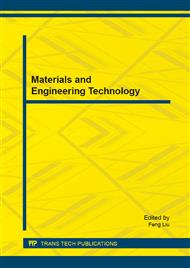[1]
E.A. Starke, J.T. Staleyt, Application of modern alluminum alloys to aircraft, Prog. Aerosp. Sci. 32 (1996) 131–172.
Google Scholar
[2]
T. Dursun, C. Soutis, Recent developments in advanced aircraft aluminium alloys, Mater. Des. 56 (2014) 862–871.
DOI: 10.1016/j.matdes.2013.12.002
Google Scholar
[3]
W. Zhang, D. Zhang, Y. Le, L. Li, B. Ou, Fabrication of surface self-lubricating composites of aluminum alloy, Appl. Surf. Sci. 255 (2008) 2671–2674.
DOI: 10.1016/j.apsusc.2008.07.209
Google Scholar
[4]
R. Menini, Z. Ghalmi, M. Farzaneh, Highly resistant icephobic coatings on aluminum alloys, Cold Reg. Sci. Technol. 65 (2011) 65–69.
DOI: 10.1016/j.coldregions.2010.03.004
Google Scholar
[5]
M. Rahimi, P. Fojan, L. Gurevich, A. Afshari, Effects of aluminium surface morphology on wettability and roughness, Appl. Surf. Sci. 2014, http/dx. doi. org/doi10. 1016/j. apsusc. 2014. 01. 059.
DOI: 10.1016/j.apsusc.2014.01.059
Google Scholar
[6]
C.J.L. Hermes, An analytical solution to the problem of frost growth and densification on flat surfaces, Int. J. Heat Mass Transf. 55 (2012) 7346–7351.
DOI: 10.1016/j.ijheatmasstransfer.2012.06.070
Google Scholar
[7]
A. Bayer, J.J. Schrijder, The Wettability of Industrial Surfaces : Contact Angle Measurements and Thermodynamic Analysis, 19 (1985) 277–285.
Google Scholar
[8]
M.K. Kwak, H. -E. Jeong, T. Kim, H. Yoon, K.Y. Suh, Bio-inspired slanted polymer nanohairs for anisotropic wetting and directional dry adhesion, Soft Matter. 6 (2010) 1849.
DOI: 10.1039/b924056j
Google Scholar
[9]
R.N. Wenzel, Resistance of solid surfaces, Ind. Eng. Chem. 28 (1936) 988–994.
Google Scholar
[10]
A.B.D. Cassie, S. Baxter, Wettability of porous surfaces, Trans. Faraday Soc. 40 (1944) 546–551., Trans. Faraday Soc. 40 (1944) 546–551.
DOI: 10.1039/tf9444000546
Google Scholar
[11]
a J.B. Milne, a Amirfazli, The Cassie equation: how it is meant to be used., Adv. Colloid Interface Sci. 170 (2012) 48–55.
DOI: 10.1016/j.cis.2011.12.001
Google Scholar
[12]
C. Dorrer, J. Rühe, Drops on microstructured surfaces coated with hydrophilic polymers: Wenzel's model and beyond, Langmuir. 24 (2008) 1959–64.
DOI: 10.1021/la7029938
Google Scholar
[13]
Y. Hayashi, A. Aoki, S. Adashi, K. Hori, Study of frost properties correlating with frost formation types, ASME J. Heat Transf. 99 (1977) 239–245.
DOI: 10.1115/1.3450675
Google Scholar
[14]
K.S. Lee, W.S. Kim, T.H. Lee, A one-dimensional model for frost formation on a cold flat surface, Int. J. Heat Mass Transf. 40 (1997) 4359–4365.
DOI: 10.1016/s0017-9310(97)00074-4
Google Scholar
[15]
K. Qu, S. Komori, Y. Jiang, Local variation of frost layer thickness and morphology, Int. J. Therm. Sci. 45 (2006) 116–123.
DOI: 10.1016/j.ijthermalsci.2005.05.004
Google Scholar
[16]
K.S. Lee, S. Jhee, D. -K. Yang, Prediction of the frost formation on a cold flat surface, Int. J. Heat Mass Transf. 46 (2003) 3789–3796.
DOI: 10.1016/s0017-9310(03)00195-9
Google Scholar
[17]
W. Wang, Q.C. Guo, W.P. Lu, Y.C. Feng, W. Na, A generalized simple model for predicting frost growth on cold flat plate, Int. J. Refrig. 35 (2012) 475–486.
DOI: 10.1016/j.ijrefrig.2011.10.011
Google Scholar
[18]
R. Tadmor, P. Bahadur, A. Leh, H.E. N'guessan, R. Jaini, L. Dang, Measurement of Lateral Adhesion Forces at the Interface between a Liquid Drop and a Substrate, Phys. Rev. Lett. 103 (2009) 26610-1–26610-4.
DOI: 10.1103/physrevlett.103.266101
Google Scholar
[19]
B. Na, R.L. Webb, A fundamental understanding of factors affecting frost nucleation, Int. J. Heat Mass Transf. 46 (2003) 3797–3808.
DOI: 10.1016/s0017-9310(03)00194-7
Google Scholar
[20]
M.D. Abràmoff, P.J. Magalhães, S. Ram, Image Processing with ImageJ, Biophotonics Int. 11 (2004) 36–42.
Google Scholar
[21]
I. Horcas, R. Fernández, J.M. Gómez-Rodríguez, J. Colchero, J. Gómez-Herrero, a M. Baro, WSXM: a software for scanning probe microscopy and a tool for nanotechnology., Rev. Sci. Instrum. 78 (2007) 013705-1–013705-9.
DOI: 10.1063/1.2432410
Google Scholar
[22]
I. Tokura, H. Saito, K. Kishinami, Study on properties and growth rate of frost layers on cold surface. pdf, Trans. ASME,J. Heat Transf. 105 (1983) 895–901.
DOI: 10.1115/1.3245679
Google Scholar
[23]
W.A. Zisman, K.W. Bewig, The Wetting of Gold and Platinum by Water, J. Phys. Chem. 1097 (1966) 4238–4242.
Google Scholar
[24]
E. Bormashenko, A. Musin, M. Zinigrad, Evaporation of droplets on strongly and weakly pinning surfaces and dynamics of the triple line, Colloids Surfaces A Physicochem. Eng. Asp. 385 (2011) 235–240.
DOI: 10.1016/j.colsurfa.2011.06.016
Google Scholar
[25]
S.H. Kim, Fabrication of Superhydrophobic Surfaces, J. Adhes. Sci. Technol. 22 (2008) 235–250.
Google Scholar
[26]
M.E.R. Shanahan, C. Bourg, Effects of evaporation on contact angles on polymer surfaces, Int. J. Adhes. Adhes. 14 (3) (1994) 201–205.
Google Scholar
[27]
C. -H. Cheng, Y. -C. Cheng, Prediction of frost groeth on a cold plate in atmospheric air, Int. Comm. Heat Mass Transf. 28 (2001) 953–962.
DOI: 10.1016/s0735-1933(01)00299-8
Google Scholar


